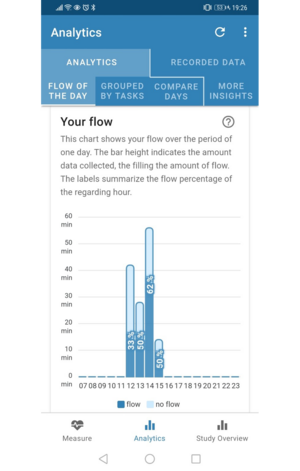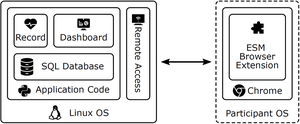AI in Human Physiology

Mobile App to improve the Understanding of Flow by Knowledge Workers
The groundwork for this research project has already been published in the CHI proceedings and IEEE Transactions on Affective Computing.
Project Abstract: Flow is defined as a state in which people are completely absorbed in their activity. Since increased flow is associated with both improved performance and an enhanced sense of well-being, this state is considered particularly desirable in the work context. Therefore, in this project, we developed a mobile flow app for knowledge workers that enables app users to better understand their flow throughout the day (e.g., when productive phases occur). The developed flow app collects physiological data, classifies flow states using machine learning methods, and presents the flow classification results aggregated and visualized in the app in addition to the physiological data (e.g., heart rate).
This figure shows a screenshot of the “Analytics” tab of the developed Flow app. A bar chart can be seen that gives users an insight into their flow experience. One bar shows the percentage of flow of the respective user in relation to the recorded data for each hour of the selected day.

Physiological Computing Infrastructure for Researching Students’ Flow in Remote Learning
This research project is published and available at Technology, Knowledge and Learning.
Project Abstract: With the advent of physiological computing systems, new avenues are emerging for the field of learning analytics related to the potential integration of physiological data. To this end, we developed a physiological computing infrastructure to collect physiological data, surveys, and browsing behavior data to capture students’ learning journey in remote learning. Specifically, our solution is based on the Raspberry Pi minicomputer and Polar H10 chest belt. In this work-in-progress paper, we present preliminary results and experiences we collected from a field study with medical students using our developed infrastructure. Our results do not only provide a new direction for more effectively capturing different types of data in remote learning by addressing the underlying challenges of remote setups, but also serve as a foundation for future work on developing a less obtrusive, (near) real-time measurement method based on the classification of cognitive-affective states such as flow or other learning-relevant constructs with the captured data using supervised machine learning.
The infrastructure was developed based on a combination of a Raspberry Pi mini-computer and a Polar H10 chest belt wearable to collect physiological data. We used “Raspbian” as the OS. An SQL database is used to securely store all data recorded by our Python application. A second application accesses the database to present the recorded data in a web dashboard. This dashboard is served by a Python web server running on the infrastructure. Users can connect to a WiFi hotspot opened by the infrastructure to access the web dashboard using their individual login credentials. Moreover, we implemented a logic for the well-established experience sampling method (ESM) as we also wanted to collect survey data. In ESM, participants are surveyed several times throughout the day for the defined study period. Specifically, the ESM logic was implemented in a browser extension for Google Chrome. In addition, the browser extension is also able to collect browsing behavior data for predefined URLs from a whitelist. Hereby, the browsing behavior and survey data are stored in a secure online database. The ESM browser extension is decoupled from the rest of the infrastructure and runs independent from the users' computer system.
